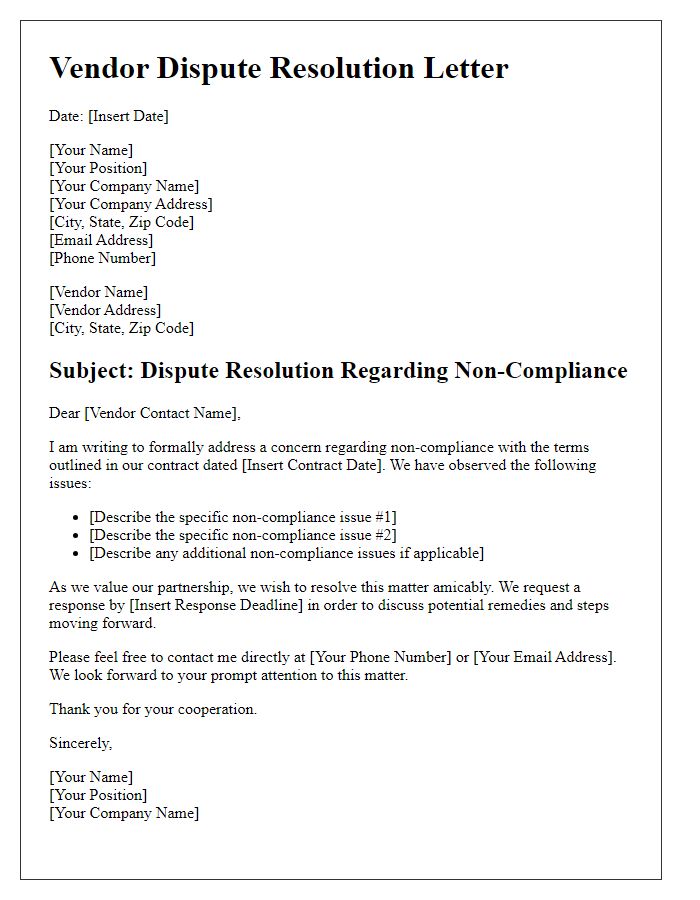When it comes to resolving vendor disputes, having a clear and concise communication strategy is essential. Crafting a thoughtful letter can pave the way for productive discussions and, ultimately, a resolution that benefits both parties. In this article, we'll guide you through the key elements of a vendor dispute resolution letter, ensuring you address your concerns effectively while maintaining a professional tone. Ready to learn the best practices for handling conflicts with your vendors? Keep reading!

Clear subject line
A clear subject line for vendor dispute resolution could be: "Urgent: Request for Resolution of Vendor Dispute - [Invoice Number/Order Number]". This specific subject line includes urgency, indicates that it pertains to a dispute, and references key details such as an invoice number or order number, facilitating easier tracking and context for the recipient.
Contact information
Vendor dispute resolution requires clear communication. Essential contact information includes the vendor's name, business address, phone number, email address, and primary contact person. For effective resolution, document all interactions, including dates and times of communication, and utilize a reference number or case identifier if available. Enhanced clarity can be achieved by specifying the nature of the dispute, such as contract violations or product discrepancies, facilitating a structured approach towards a prompt resolution. The goal is to foster a collaborative environment where both parties can address concerns constructively.
Detailed issue description
In late September 2023, a significant issue arose regarding an unresolved invoice discrepancy with XYZ Supply Company, located in Chicago, Illinois. The invoice, dated September 15, 2023, under invoice number 12345, includes charges for goods received on August 30, 2023. However, discrepancies occurred as the quantity billed (200 units) exceeds the delivered quantity (150 units) as per delivery note number DN6789. Repeated attempts to resolve this issue through emails and phone calls with the vendor's customer service department have not yielded a satisfactory response. Additionally, the agreed payment terms outlined in the purchase order dated July 10, 2023, stipulate that payment should only occur upon confirmation of receipt, further complicating the situation. This discrepancy has disrupted our financial planning and strained our relationship with the vendor. Immediate attention and resolution are needed to address these urgent concerns.
Supporting evidence and documentation
Accurate documentation is crucial in vendor dispute resolution, ensuring a clear understanding of the issue at hand. Supporting evidence may include invoices (detailed statements of goods and services), correspondence (emails or letters exchanged), contracts (signed agreements outlining terms), and photographs (visual proof of discrepancies or damages). Records of delivery dates (timestamps of when products were received), performance metrics (evaluations of vendor reliability), and payment records (transaction confirmations) also enhance the validity of claims. Each piece of evidence builds a comprehensive narrative, vital for facilitating resolution through negotiation or arbitration, potentially involving third-party mediation services for unbiased assessment.
Desired resolution or outcome
Desired resolution for the vendor dispute includes full restitution of financial losses incurred due to non-compliance with agreed contract terms, specifically regarding delivery delays exceeding 30 days that occurred in September 2023. Furthermore, a formal apology letter addressing the issues related to service quality is requested. This resolution aims to restore goodwill and maintain future business relationships, while additionally ensuring that corrective measures are implemented to prevent recurrence of similar issues. Timely communication from the vendor, within 14 days, is essential to discuss further steps and negotiate any adjustments to the existing contract.
Letter Template For Vendor Dispute Resolution Samples
Letter template of vendor dispute resolution for service level agreements

Letter template of vendor dispute resolution for communication breakdowns

Letter template of vendor dispute resolution for non-compliance concerns

Letter template of vendor dispute resolution for product recall situations









Comments